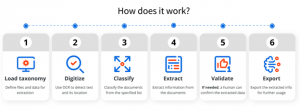Unleashing the Power of Document of Understanding Software: Machine Learning, RPA, and ROI Benefits
Discover how Machine Learning and Robotic Process Automation can revolutionize your Document of Understanding and maximize your ROI
Introduction
In today’s competitive business landscape, maximizing your return on investment (ROI) is crucial. One way to achieve this is by harnessing the power of Document of Understanding (DoU) software, specifically Machine Learning (ML) and Robotic Process Automation (RPA). This comprehensive guide will explore the advantages of utilizing ML and RPA for your DoUs, outline the ROI benefits, and provide actionable steps on how to get started. DoU software can be tricky as it is either not very good or requires a fair amount of training. In either case, it is important to have a plan going forward for its usage.
The Role of Machine Learning and Robotic Process Automation in Document of Understanding Software
Machine Learning and Robotic Process Automation are two technologies that can be applied to DoU software to improve its efficiency and effectiveness. By leveraging ML and RPA, you can automate tasks, streamline processes, and enhance the overall management of your DoUs.
Key ROI Benefits of ML and RPA in DoU Software
Implementing Machine Learning and Robotic Process Automation in your DoU software can lead to significant ROI benefits:
- Reduced Human Error: ML and RPA can minimize the potential for human error, ensuring higher levels of accuracy and consistency in your DoUs.
- Increased Efficiency: Automation of routine tasks and data processing allows your team to focus on more strategic initiatives, boosting overall productivity. Specifically when replying to tedious forms, or looking for specifics to translate to data inside your system.
- Enhanced Decision-Making: ML algorithms can analyze large volumes of data to identify patterns and trends, enabling better-informed decision-making.
- Cost Savings: By automating manual tasks and improving efficiency, ML and RPA can lead to significant cost savings in the long run.
- Scalability: ML and RPA-driven DoU software can easily adapt to your business’s growth, ensuring your investment yields long-term benefits.
How to Get Started with Machine Learning and RPA in Your DoU Software
Implementing ML and RPA in your DoU software involves the following steps:
- Assess Your Needs: Begin by evaluating your current DoU processes and identifying areas where ML and RPA can provide the most significant benefits. We have seen this often done in the proposal response forms for government work or general RFP’s that are issued consistently by clients.
- Research and Choose a Vendor: Conduct thorough research to find a reliable DoU software vendor that offers ML and RPA capabilities. Review their case studies and client testimonials to gauge their expertise. UiPath has DoU capabilities as part of their suite.
- Develop a Plan: Work closely with your chosen vendor to create a detailed implementation plan, outlining the specific ML and RPA features that will be incorporated into your DoU software. You should always complete a process design document to articulate the core benefit expected.
- Train Your Team: Ensure your team is well-versed in the new software and understands how to leverage the ML and RPA features effectively. Many times this will catch portions of what you need, for example if you are filling out RFP’s, but there will likely need to be some human intervention. This should be incorporated into workflow.
- Monitor and Optimize: Continuously monitor the performance of your ML and RPA-enabled DoU software, making adjustments as needed to maximize your ROI. Your DoU is only as good as the model you train it on.
Conclusion
By integrating Machine Learning and Robotic Process Automation into your Document of Understanding software, you can unlock a wealth of ROI benefits, including reduced human error, increased efficiency, enhanced decision-making, cost savings, and scalability. By following the steps outlined in this guide, you can successfully implement ML and RPA into your DoU software, setting your business on a path to greater success and improved ROI.
Talk to Lanshore about how to implement DoU or other services: Contact US
Below is a snippet of the UIPath document understanding framework: (https://www.uipath.com/blog/product-and-updates/introducing-document-understanding-process-documents-intelligently)
Document Understanding framework
A composable Document Understanding framework is available as drag-and-drop activities used to build automation workflows in UiPath Studio.

- Load taxonomy – define documents and data to be processed using the Taxonomy Manager.
- Digitize – use one of the available optical character recognition (OCR) engines to digitize the text and determine its location.
- Classify – classify the documents from the user-specified list.
- Extract – choose the most suitable extractors according to your document type (see more details on extraction techniques in the following section).
- Validate – if needed, a human can check in to confirm or correct the extracted data or handle exceptions.
- Export – send the extracted info for further usage, for example, to email, spreadsheet, or SAP software.
